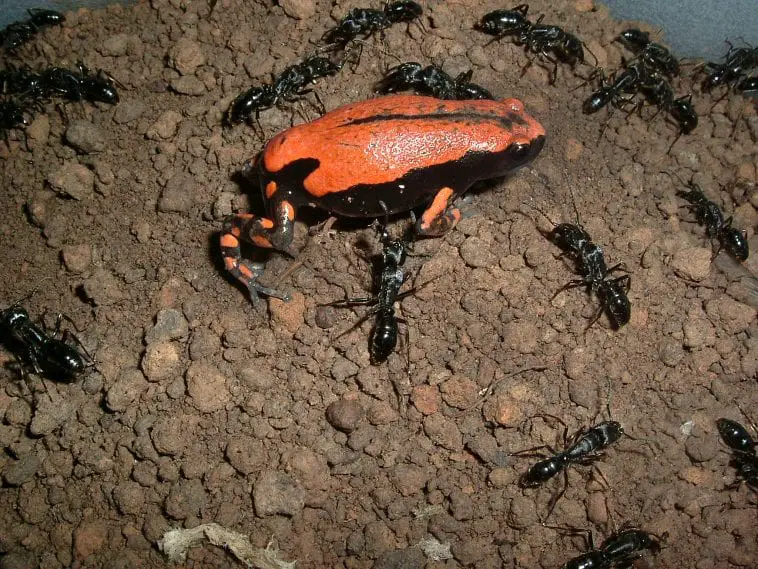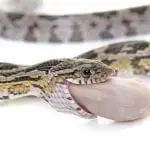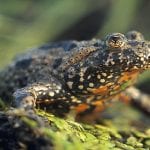Frogs are voracious eaters and will eat anything that they see or anything that walks past them. They will eat anything as long as its smaller and can fit their mouths. Crickets may be the staple food of most frogs, but ants can also be a regular on their diets. Why is this so?
- Ants are everywhere on the forest floor or trees. When there’s fruits and rotting fruits, you’ll surely find ants nearby.
- Ants are smaller than the tiniest frog and thus are easy to eat. A frog may not be satisfied with one or a dozen ants, but it is unlikely you’ll find only one or two ants nearby.
- Ants are safer than other insects because they are less likely to travel far and become affected by pesticides, fertilizer, and herbicides. Your pet frogs will be safe with ants.
- Ants are economical for a pet owner. You can keep an ant farm and have hundreds of ants for your pet frogs
- Ants are easier to digest than other insects like grasshoppers and crickets because of their size.
- Ants are less likely to bite your pet because the frog will gobble them up without hesitation. Large bugs can become very feisty, bite your pet, and hurt it before these are consumed.
Quick answer
To answer the question, yes, it’s safe, but some ants may not be as safe to eat. Eating fire ants, for instance, can become a challenge for frogs. Fire ants sting, and the toxin in every bite can cause hive-like lesions, which can itch and burn. In humans, livestock, and other animals, fire ant bites can cause pus-filled lesions when the bite is overlooked. If you are bitten several times, a toxic or very severe allergic reaction may happen.
Frogs will also suffer the same fate. The toxin from the bite of the fire ant or many fire ants can instantly kill your pet.
How many ants to feed your frog?
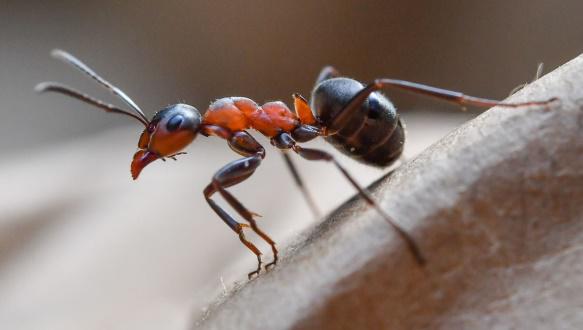
We are talking about safe and non-toxic ants to feed frogs for this guide. How much ants to feed your frog depends on the size of your frog, its metabolism, and any calorie needs.
According to a forum at AntsCanada.com, a regular-sized frog may be fed 20 ants a day. But take note that if you have two or more frogs, then its twenty times two, three, or more. You may need to have a sufficient ant colony that has a thousand ants with a queen capable of laying around 20 or more eggs in a day. This means that you must start an ant colony sufficient for a daily food supply for each frog.
Take note that ants are not as nutritious and as sumptuous as crickets and grasshoppers. Your frog will likely become malnourished or lack important nutrients in its diet if you depend solely on ants for their food. Therefore, take ants as snacks or supplements and still provide protein-rich grasshoppers and crickets for your pet.
How often to feed ants to your frog?
How often depends on how young your frogs are. Smaller frogs may be given 20 or more ants daily, while older ants may only need to be fed 20 or 30 ants every other day or a few times a week. Frogs that need nutrition or malnourished and sick frogs should not rely on ants alone. Again, feed it crickets, grasshoppers, or wasps to provide protein and other nutrients.
Fire ants vs. Poison Frogs
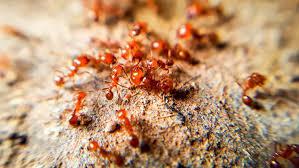
We just had to highlight this special feature from the USDA (United States Department of Agriculture) in 2014 regarding the plight of humans and livestock against the wrath of the fire ant.
According to the post, the fire ant was initially introduced in the United States in 1930 from South America. It was the red imported fire ant or the Solenopsis invicta that spread all over the southern parts of the United States, and this ant was able to ravage small animal populations, destroying crops and plants and giving people and livestock venomous stings. Because of the wrath of the Solenopsis invicta on everything on its path, scientists sought any kind of method to control it.
Researcher Robert Vander Meer from the Imported Fire And and Household Insects Unit from the Agricultural Research Services Center for Medical, Agricultural, and Veterinary Entomology has partnered with other scientists to find out whether the toxic chemicals in poison dart frogs may be enough to match the toxins of these ants.
The toxic alkaloids which are naturally occurring in the skin of poison dart frogs were found in the 1960s in South America and Central America. Amerindian tribes were the first to discover the toxic effects of these alkaloids, and they learned how to get these secretions to make poison dart frogs. These darts were used for hunting.
Take note that poison dart frogs do not make the alkaloid poison by themselves. They need to eat poisonous critters like millipedes, mites, ants and other arthropods to be able to produce these alkaloids.
Vander Meer and his team of researchers created a way to measure the number of toxins in 20 different species of poison frogs. The scientist exclaimed that they were able to identify and catalog more than 900 alkaloids from poison frogs.
In areas of Central America where tropical fire ants are prevalent, these ants occupy the same area as the poison dart frog species Oophaga pumilio. The predominant alkaloid that is excreted by the tropical fire ant is also found in the skin of the poison dart frog, considering that this frog eats these ants. However, tests show that this alkaloid may not be as effective against ants like the S. invicta.
Vander Meer also said that the same poison dart frog has a diet that consists of mites and ants. This discovery seems to support the theory that poison dart frogs are not affected by the fire ants when in their natural habitat. But if these frogs are cared for with a diet that doesn’t contain these alkaloids, they will be attacked by the fire ant when exposed.
Also, when the frogs have the alkaloids in their bodies, these will be modified. Without first ingesting these compounds as starting material, these frogs won’t be able to create toxic alkaloids in the skin. This is partly one of the results of their study, and this was published in the Naturwissenschaften in 2013.
What to feed your frogs?
As mentioned before, ants won’t be able to support a frog’s daily caloric needs. So before you add a pet frog, sit and plan out its menu. Remember, frogs are carnivores and are also predators, so you need to offer a steady amount of live food or fresh prey to your pet.
Feeding a frog is more than just placing two or three crickets inside the frog’s terrarium. Its diet has to be according to its species, age, the number of frogs inside the cage, and its breeding status.
The type of frog species you have greatly influenced the type and number of food you will feed your frog. For instance frogs with a faster metabolism like dwarf frogs may need to eat crickets daily (one cricket per day or in the case of ants, 20 or more ants a day) while frogs with slow metabolisms like the Whites tree frog may only need to be fed once a week or even once every other week with a cricket or two.
The age of the frog also affects its diet. Juvenile frogs need to be fed daily because these need more protein than adult frogs. Meanwhile, adult frogs require feeding every other day.
The number of frogs in the cage also affects the number of food you feed your pets. Consider a tank with around three frogs, and it’s feeding time. You load one cricket, and the most dominant frog snatches it as soon as it is placed inside the tank. And of course, you load another cricket, and the same frog takes it. What about the other two? How do you feed them?
This is actually what happens in the wild. Frogs compete for food, especially when food is scarce in the area. So to help non-dominant frogs, you should release three or more crickets or live food inside the cage. You can also use chopsticks to feed weaker frogs, so the strong and dominant ones don’t stand a chance. Now feeding many frogs with ants is another thing because ants will be all over the cage before you know it. It will be a fun fiesta for all of the frogs inside the tank!
Finally, the breeding status of frogs can also affect the type and amount of food you feed them. Frogs, especially female frogs, which are in the breeding stage, will likely require more food. Females with eggs also need to be fed daily, and again, a sole diet of ants will never cut it. Feed your females with high protein food and dust the food with calcium so it can help produce healthy eggs.
Aside from ants and crickets, what else to feed your frogs?
Frogs are carnivores, and a diet composed of insects is the best diet to give. Aside from ants and crickets, you may also give critters like locusts, grasshoppers, mealworms, waxworms, and for larger frogs, pinkie mice.
You can give your pet crickets once every other day and a choice of ants, hoppers, and mealworms on the days in between. Mice is very rich in protein, and thus it should only be given once a week; take it as a treat for larger frogs.
You can get live food from local pet shops or pet stores online. It’s best to develop a good working relationship with pet shop owners that sell this kind of food. Although not that necessary, being good friends with the owner can help you get the freshest and the best kind of food for your frog.
You may also make your food if you wish, and ants can be easy to make. Just place a piece of food like ripe fruit, bread, or candy in an area in your garden or yard where ants are likely to be. Leave this piece of food for a few hours and come back for it to harvest your mini ant colony.
How much food to feed your frogs?
Frogs have no natural control over their appetites. These creatures may eat endlessly until they don’t have any food on their plates. And eating too much can make your pet very ill and can also contribute to obesity. Therefore, you should feed your pet calorie-rich foods only in moderation. Calorie-rich foods such as pinkie mice should only be given to pet frogs once a week and not daily.
Feed your frogs ants up to 20 to 25 ants every other day or three times a week. Feed adults with 5 to 7 crickets several times in a week. Meanwhile, froglets should be fed with crickets once a day. If you are unsure about the amount of food or the type of food that your pet needs, you should consult your vet before you feed it.
What not to feed frogs?
There are the right foods to feed frogs, and there is non-so good and not-so-safe food as well. For instance, fire ants may only be given in moderation to avoid fogs acquiring their toxins. You must also avoid insects that are caught in your yard like grasshoppers, crickets, and moths because these can have toxins from eating food from other gardens and fields.
Never feed your frog larger food because large and complicated food can lodge inside its throat or gut, which can dislodge in your pet’s body. If this happens, your pet may not be able to breathe, or it can die as well.
Never feed frogs with human food, table scraps, and cat or dog food. These are not fit for your frog’s digestive tract and may contain dangerous toxins, which can have adverse effects on your pets.
The ideal size of prey for your pet frog
Ants are easy to feed to your frogs because they are very tiny, but what about larger prey like crickets and grasshoppers? The thing is, most frogs don’t eat anything that’s bigger than their mouths, but still, crickets and grasshoppers have complicated structures with large wings, legs, and arms that can be too hard to swallow.
So your frog can have a fun and relaxing dinner, feed it only live food that is smaller than his head or better yet, smaller than the area between its eyes. This is a pretty good estimate since most frogs have large mouths and a sizeable distance between their eyes.
If you are still unsure about what size of prey you can give your pet, better feed it flies or ants instead-but take note that this should not be for long. As soon as your pet is larger or is an adult, you may start giving it medium-sized crickets just to be on the safe side.
How to deal with accidental ingestion?
Another possible problem with giving your pet frogs some ants is that ants tend to crawl everywhere. These will crawl on the terrarium walls, plants, and accessories instead of just staying on the bowl. Frogs will likely follow them around, sticking their tongues on each creature, and as this happens, your pet can accidentally ingest undigestible objects like gravel, sand, or other loose substrates.
When this happens, the undigestible substrate will just settle in the gut of the frog and soon will cause impaction. Sometimes there’s no hope for a frog with impaction; this is why you must consider very well the kind of substrate you want to use in your enclosure.
Use a safe, stable substrate that will never tear apart, even when used over and over again. A good, widely-recommended substrate is Astroturf. You will find Astroturf and other substrate products from your local pet shop or pet store.
Offering water to your pet frog
Apart from planning on the right type of food to provide for your pet frog, you should also consider how to add water into the picture. Frogs are like any other living creature because they need water. Even arboreal frogs require a regular amount of freshwater inside their tanks, and thus you must leave at least a small bowl of freshwater inside it. Use dechlorinated water or tap water as long as you are sure that it does not contain any chlorine.
Chlorine, as well as other minerals in the water, can be very toxic to your pet and feeding it water with trace amounts of chlorine can be lethal. So make sure that your water is safe before you place it inside a frog’s terrarium.
Another way to add water inside the terrarium is to spray water with a fine mist. Your pet frog will lick the wet surfaces of the aquarium walls, plant leaves, and even on itself to drink. Also, spraying water inside the tank can help improve the humidity of the tank, and this can also help your pet frogs.
About supplements
Frogs are just like any amphibian and reptile that needs supplements and nutrients to survive. One of the most important is calcium, a mineral that’s needed for strong bones, bone development, and repair. Calcium is not available in most frog’s diets, and to supplement with calcium use calcium powder to dust your food.
Dust crickets, grasshoppers, and moths with calcium powder and feed to your pet every other day. Another important nutrient is vitamin A which is needed in many vital functions of the body. To add vitamin A in your pet’s food, start by feeding insects with vitamin A rich food like carrots, sweet potatoes, cantaloupes, and lettuce. Doing this will prepare the insects, and this will benefit your pet greatly.
Create a schedule to administer supplements to your frog. An example is to dust food with calcium every Monday, Wednesday, and Friday, while vitamins and mineral-loaded insects should be given during Tuesdays, Thursdays, and Saturdays.
Important tips on how to feed ants to your pet frog
- Not all ants are safe for your pet. Fire ants for one can be dangerous and can make frogs, especially dart frogs, develop toxins in their skin.
- Ants are handy to feed your frogs because these can be found anywhere and are small enough to be eaten even by small frogs.
- Ants are easy to find, and you can also get ants for your pet by simply placing ripe fruit pieces, bread, or candy outside in your garden or yard.
- Ants are quite a challenge to give to your pet without dealing with impaction. This is why you must use a stable, solid substrate like Astroturf instead of sand or gravel in the terrarium.
- Your pet frogs can’t live on ants alone. You must still feed it other food like crickets, grasshoppers, or moths. Ants don’t have high protein amounts, and protein is important for growing frogs.
- Aside from eating live or alive food, pet frogs should be given safe water for drinking and for improving humidity inside the tank.
- You should also add supplements to improve your pet’s health. The most important are vitamin A and calcium.
Take your pet frog to the vet
And just like other pets, a frog has to be taken to the vet for checkups. A vet can check if your pet is getting the right kind of food and nutrition. He will also recommend the best kind of nutrients or supplements for your pet.
It’s best to take your pet to a vet that specializes in amphibian care to diagnose any illness or medical condition of frogs better. Finally, if one frog is sick, quarantine this pet to avoid the spread of illness. Wash your hands after handling amphibians and reptiles to avoid the spread of deadly diseases such as salmonella.

